Abstract
The Citrus clementina (citrus) plant produces various phytohormones due to the significant involvement of the carotenoid cleavage oxygenase (CCO) gene family in its growth and development. CCO genes can be divided into two main categories: NCED (9-cis-epoxy carotenoid dioxygenase), responsible for abscisic acid (ABA) production, and CCD (carotenoid cleavage dioxygenase), involved in pigment and strigolactone formation. To better understand the roles and positions of CcCCO gene members in relation to these hormones, researchers analyzed the clementine genome. To identify their structural features, they employed phylogenetic analysis, protein interactions, localization, structure, miRNA targets, evolutionary analysis, and transcriptome studies. The study revealed the presence of 15 CcCCO genes, including 11 NCED and 4 CCD genes, scattered across various chromosomes, with the majority located in chloroplasts. Promoter sequencing analysis indicated the presence of different cis-regulatory elements that likely interacted with phytohormones, such as auxin and abscisic acid among others. Notably, two genes, CcNCED1 and CcNCED3, were significantly expressed among the CCO genes, and these were found to be expressed during stress and played a crucial role in enabling optimal plant development. Furthermore, a comprehensive genome-wide comparison of CCO genes in C. Clementine and Arabidopsis thaliana models was conducted to understand their functional characteristics. This research provides a solid foundation for further exploration of the unique attributes of the C. clementina plant, contributing to a deeper understanding of its growth and development processes.
1. Introduction
Carotenoids signify the class of naturally existing pigments which are prevalent in a broad variety of animals, plants, and microbial organisms [1]. Carotenoids are a group of C40 isoprenoid pigments that are essential for photosynthesis and photoprotection [2]. More than 700 distinctive carotenoids have been observed and characterized since their discovery in the 19th century [3]. The CCO genes mold into an ancient family. The maize (Zea mays) ABA-deficient viviparous mutant, vp14, was the first gene expressing a CCO [4]. Carotenoid cleavage oxygenases (CCOs), as non-heme iron oxygenases, play a crucial role in the oxidative modification of carotenoids, leading to the production of apocarotenoids. These apocarotenoids serve various functions in plants, including acting as phytohormones, pigments, and protective compounds [5]. Plant CCOs can be further split into the NCED (9-cis-epoxy carotenoid dioxygenase) and carotenoid cleavage dioxygenase (CCD) subfamilies based on whether the substrates are epoxidized [6]. However, the RPE65 (retinoid isomer hydrolase RPE65) domain of the NCED and CCD genes is similar as well [7].
The CCD gene family in Arabidopsis thaliana includes nine members, containing five NCED genes (AtNCED2, AtNCED3, AtNCED5, AtNCED6, and AtNCED9) and four CCD genes (AtCCD1, AtCCD4, AtCCD7, and AtCCD8) [8]. Recently, the plant species Vitis vinifera (grape), Malus domestica (apple), and Solanum lycopersicum (tomato) were revealed to have the CCD-like subtype of CCO genes [9,10]. It was discovered that the first CCD1 enzymes studied (AtCCD1) conducted a twofold cleavage of carotenoids, e.g., β-ionone, and one C14-dialdehyde, which play an important role in the formation of the flavor and scent of horticultural plants [11]. Natural variation in the CCD4 gene promoter is a primary genetic predictor of natural variation in C30 apocarotenoids, which cause citrus peel to be red [12]. The CCD7 and CCD8 enzymes are involved in the synthesis of strigolactone, which might be able to regulate shoot branching and reproductive development and also affect how plants react to salt and drought stress [13]. Different crop studies of rice (Oryza sativa) and maize (Z. mays) highlight the variety of roles and activities that CCD enzymes play in these plants and their participation in a range of biological processes, such as fruit ripening, hormone production, and plant growth [14,15].
The process mediated by NCED is a rate-limiting stage in ABA production, which impacts plant tolerance to various abiotic stressors [16]. Each of the three key components of developmentally mediated ABA production in seeds, AtNCED5, AtNCED6, and AtNCED9, maintains their maturation and dormancy at the embryo stage [8]. In A. thaliana roots, AtNCED2 and AtNCED3 genes are prevalent, and the proteins they encode contribute to the synthesis of abscisic acid, which controls lateral roots [8]. The significance of NCED genes and ABA production in agricultural plants has previously been highlighted by research on tomato (S. lycopersicum) and A. thaliana, notably in response to water stress and other environmental difficulties [17]. Both enhancing crop resilience and creating tactics for greater stress tolerance in agriculture can benefit from an understanding of the regulation and function of NCED genes. The natural levels of ABA in tomato plants are reduced by specifically hindering the function of the NCED gene. This drop in ABA level delays the fruit ripening process [18]. A massive 46% decrease in ABA levels appears in strawberry fruits when the FaNCED1 gene is silenced using the Tobacco Rattle virus [19].
The clementine is a seedless citrus fruit in the Rutaceae family, resulting from a cross between mandarin orange and sweet orange. It is renowned for its small size, delicious flavor, and great nutritional content. The commercially grown clementine is an essential component of international agricultural markets and commerce. The genome of the sweet orange, including the clementine variant, was recently sequenced and examined by a global team of academics. This landmark research provided a comprehensive understanding of the genetic makeup of C. clementina and laid the foundation for subsequent genomic studies on citrus species. The genome size of C. clementina is estimated to be approximately 367 million base pairs (Mb) or 367,000,000 base pairs. The complete genomic sequence of Citrus clementina (commonly known as C. clementine) was published in 2011 [20].
In citrus plants, the CCO family is essential for cellular respiration and energy production. It is found in the mitochondria, where it catalyzes the reduction of molecular oxygen to water while transferring electrons. In the context of gene expression studies, the genes CcNCED2 and CcNCED4 demonstrate an increase in expression levels, indicating upregulation. This process generates the energy needed for various metabolic activities within the citrus cells. In our study four CCD and eleven NCEDs were discovered; these findings open the door for the future. Continued research on C. Clementina’s genetic makeup, including genomics and transcriptomics, may unveil new insights into its unique characteristics, leading to the development of novel cultivars and improved cultivation practices to meet evolving consumer demands.
2. Results
2.1. Identification of CCO Genes in Citrus Clementine
There are actually fifteen CcCCO genes reported in the C. clementina genome (shown in Table 1), of which eleven are NCED and four are CCD. With CcNCED12 being the smallest and CcNCED9 being the longest protein, the CcCCO genes that code for it range in size from 410 to 609 amino acids (AA) and from 45,860.27 to 69,176.61 Da molecular weight (Mw). The identified proteins have pI values ranging from 5.79 to 8.53. These 15 CcCCO genes were subcellular localized, and the bulk of the genes were found in the cytoplasm, peroxisomes, and chloroplast (Figure 1). Some were found in the nucleus and mitochondria. The last of them were also found in plasmids, extracellular structures, vacuoles, and E.R, etc.

Table 1.
NCED and CCD genes in CCO gene family information for 15 non-redundant genes discovered in the C. clementina genome.
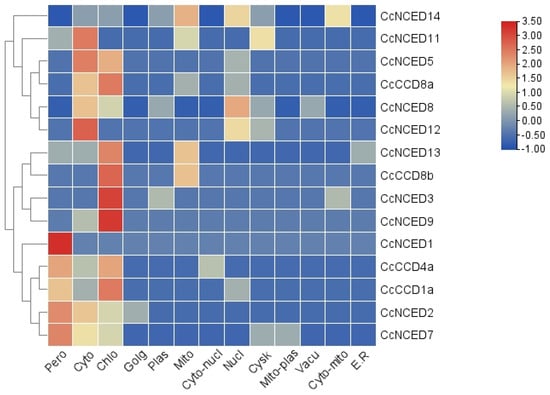
Figure 1.
Heat map illustrating the subcellular localization of all 15 CcCCO genes to the nucleus, cytoplasm, chloroplast, Golgi apparatus, mitochondria, plasmid, and peroxisomes of the plant cell. The blue color indicates the lowest functional activity or expression of the relevant gene in the specified region, and the red color denotes the highest functional significance of the relevant gene in the indicated region.
2.2. Phylogenetic Analysis
The reference sequences of 15 CcCCO genes from C. clementina, 10 genes from C. sativus, 8 genes from A. thalianan, 12 genes from C. maxima, and 13 genes from C. pepo were used to construct a phylogenetic tree. All 61 CCO genes were utilized for the tree. The phylogenic investigation revealed that the CcCCO genes were made up of three NCED genes and four CCD genes. The phylogenetic tree was categorized based on the presence of A. thaliana genes in each clade. According to the analysis, the CcCCO genes can be classified into two main groups, CCD and NCED, which are further subdivided into six subgroups: CCD1, CCD4, CCD8, NCED1, NCED2, and NCED3. Among these, CCD8 is the largest subgroup with 19 genes, followed by NCED3 with 12 genes. CCD1 ranks third with 10 genes, while NCED1 and CCD4 contain 8 and 10 genes, respectively. The smallest group is NCED2, which consists of only four genes (Figure 2). A clementine gene was not found in the CCDL subgroup, which is noteworthy. The study revealed that citrus clementine harbors two genes in the CCD8 clade and five genes in the NCED3 clade. In contrast, NCED1 and NCED2 lack genes, while CCD1 possesses only one gene. Interestingly, CCDL genes form a distinct clade in another crop. Their significance remains uncertain due to their absence in A. thalianan. The CCD4 clade contains two Cp genes and one gene each from Cs and Cm. Within the NCED1 clade, there are four Cs genes, accompanied by two genes from Cp and Cm. The CCD8 clade comprises five, one, and two genes from Cm, Cp, and Cs. Finally, NCED2 encompasses two genes, originating from Cp and Cm.
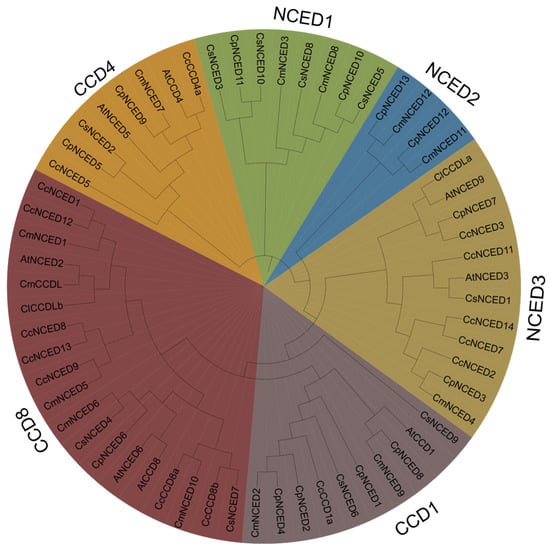
Figure 2.
A phylogenetic tree restoration method, which is often employed used in research on A. thalianan, was utilized to determine the phylogenetic connections of 61 CCO genes from five different families, including C. clementine, C. sativus, A. thaliana, C. maxima, and C. pepo. Based on their associated evolutionary features and traits, the five crop species are split among the 61 CCO genes in the figure.
2.3. Gene Structure, Motif, and Domain Analysis
In accordance with the CcCCO gene structure suggested by the intron–exon analysis, seven of the fifteen genes—CcCCD1a, CcCCD4a, CcNCED3, CcNCED5, CcNCED7, CcNCED8, and CcNCED9 have one exon and no intron. Six exons and five introns exist in the two genes CcNCED11 and CcNCED13. Other genes include CcNCED1, which has 15 exons and 14 introns, CcNCED12 which has 10 exons and 9 introns, CcCCD8b which has 3 exons and 2 introns, CcNCED14 which has 7 exons and 6 introns, and CcNCED2 which has 14 exons and 13 introns (Figure 3). This research demonstrates that, in contrast to other genes, those genes with the same number of introns and exons share common jobs and ancestry.
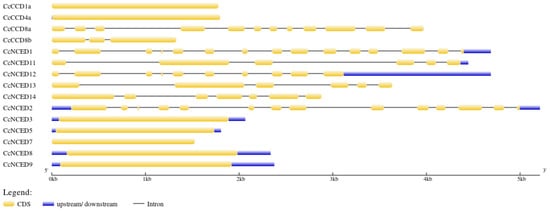
Figure 3.
The intron–exon structure is phylogenetically represented, and it shows that CCD genes contain fewer coding sequences than NCED genes. The number of introns and exons in several NCED and CCD genes has remained constant.
Fifteen CcCCO genes were subjected to motif analysis, revealing the presence of 20 different motifs. Interestingly, one pattern was found to be conserved in all 15 genes, indicating that it is vital to their operation (Figure 4). Motif 2 is conserved in all identified CCO genes while motif 5 is present in 14 CcCCO genes out of 15. In addition to their respective domain analyses, the RPE65 domain is the prominent domain present in CCO genes and has subdomains such as PLN02258, PLN02969, and PLN02491 that are present in CcCCO genes (Figure 4).
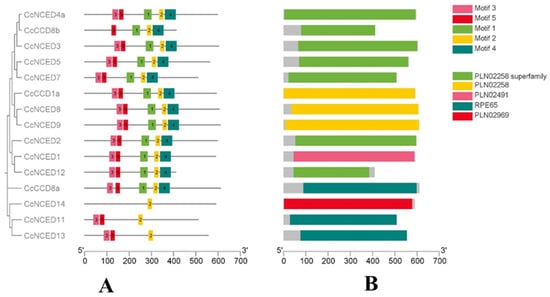
Figure 4.
The distribution of 20 motifs along the 15 members of the citrus clementine CCO protein family. Some members of the NCED and CCD proteins have a conserved motif shown in (A), while the conserved domain in each of the CCO genes is depicted in (B).
2.4. Evaluation of Duplication Event of C. clementine
Through the use of a relatively simple ka/ks calculator, TB tools determined the values of ks, ka, and the ka/ks ratio of the CcCCO genes. The ratio of synonymous to nonsynonymous changes was expressed as ka/ks, where ks represents the number of synonymous substitutions per synonymous site and ka represents the number of nonsynonymous substitutions per nonsynonymous site. This ratio ranged from 1.98 in the CcNCED7/CcNCED13 pair to 0.08 in the CcNCED8/CcNCED9 pair. When all of the genes’ ka/ks values are less than 1, all of the genes are subject to replacement, which preserves the functional integrity of the gene by eradicating undesirable modifications. All paralogous pairs in citrus clementine had a Ka/Ks ratio greater than 0.05 which suggested the probability of significant functional divergence in the duplication process due to purifying selection (Figure 5).
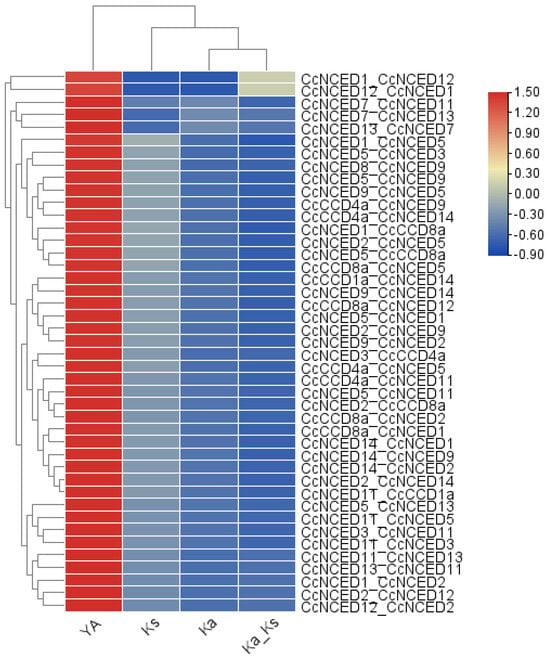
Figure 5.
The expression ka/ks represents the ratio of mutations involving synonymous substitutions (ks) to mutations involving nonsynonymous substitutions (ka). The gene duplication over selection and evolutionary pressure to paralogous pairings of C. clementina CCO genes were calculated based on ks and ka values.
Based on their chromosomal positioning, the chromosomal localization study suggested that CcCCO genes were meant to be divided over several chromosomes. On the first spot, CcCCD8a, CcNCED13, and CcNCED11 were present. CcNCED3, CcNCED2, CcNCED12, and CcNCED1 were present on the fourth position. On position six, CcCCD4a and CcCCD8b were seen. The locations of CcNCED5 and CcNCED7 were eight and nine, respectively. On two, three, seven, and ten there were instances of CcNCED9, CcNCED8, CcNCED14, and CcCCD1a. The clustering of CcCCO genes on chromosomes 1, 4, 5, and 8 may reflect functional or regulatory coherence, as functional clusters are known to enhance co-expression and coordinated regulation in plants and other organisms (Figure 6). This phenomenon could be the result of selection pressure, gene duplication events, and chromosomal rearrangements that facilitated the retention of essential functions in the C. clementina genome. The clustering may also indicate a role in metabolic pathways or stress responses, consistent with findings in other organisms [21].
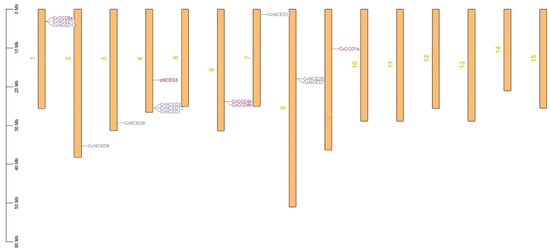
Figure 6.
The C. clementina genome’s chromosomal mapping of the CCO genes shows the existence of paralogous copies with plausible locations.
Synteny offers a structural foundation for understanding the preservation of similar genes and their orderly organization across genomes of the same species. It involves identifying conserved regions between two sets of chromosomes that are being compared. Dual synteny is the term used to describe the conserved pairing of genes on chromosomes in different animals. Two genetic sites may become separated through evolutionary changes to the genome, such as chromosomal translocations, which can separate two genetic positions. This technique gives a visual representation of the degree of similarity through genomic regions using pink and blue shades. Gene duplication is a result of an array of dynamic mechanisms and genomic rearrangements that allow the genes to remain stable secure, adapt to their environment, and gain new properties over time (Figure 7A). In the genomes of these plant species, our research revealed instances of slight structural and gene duplication sharing (Figure 7B).

Figure 7.
Genes with structurally similar sequences share conserved areas, according to an in-depth study of genome-wide synteny in clementine CCO genes (A). Dual synteny examinations were carried out to assess the degree of structural similarity and the distribution of gene copies between the genomes of C. clementina, A. thalianan, and C. clementina–Citrus sinensis (B).
2.5. Analysis of CcCCO Cis-Regulatory Elements
The spatio-temporal transcriptomic expression of genes is influenced by the presence and arrangement of numerous cis-regulatory elements at the binding site of transcription factors on the promoter region. Therefore, research using the PlantCare database was undertaken to assess the possible roles of CcCCO genes. Light-responsive, endosperm-specific, hormone-specific, meristem-specific, metabolism-related, stress and defense-related cis-regulatory elements made up of clementine CCO genes were studied. The CCO gene family in C. clementina contained 69 cis-regulatory elements that are responsive to light (Figure 8).
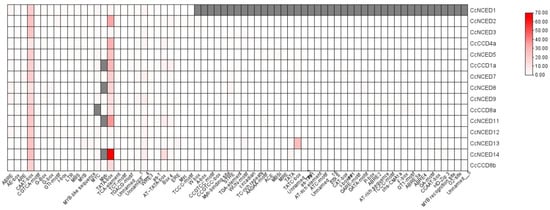
Figure 8.
The visual depiction of the CCO gene’s cis-regulatory analysis along with the strength of each function. The red (highest) to the white (lowest) intensity is used to describe the biochemical and physiological activities happening in plants.
The ABA reaction is regulated by the AAGAA motif element, a basal promoter element with the ATTATA-box structure. BOX 4, and G-Box engaged in reactivity to light. The CAAT box element controls meristem expression. Meanwhile, the MeJA responsiveness of the CGTCA motif element is also important. The MYB is involved in cell proliferation and the cell cycle. Myb, AT-Rich Element, MRE, ERE, CGTCA-motif, and STRE all exhibit wound responsiveness. The WUN motif and W-box trigger a protective reaction. Defense and stress reactivity is influenced by TC-rich proteins, and GATA-motif, LTR, LAMP-element, CGTCA-motif, MBS, and TCT-motif elements each serve a specialized purpose. Both AE-box and ARE are crucial for triggering aerobic induction. All other elements, including ACE, TGA element, circadian, MYB-like sequence, Myb-binding site, GTI-motif, Unnamed_2, Unnamed_16, I-box, P-box, and GARE-motif, are engaged in various roles.
2.6. Analysis of Protein–Protein Interaction Network
The CcNCED14 gene has associations with all the other genes, according to protein–protein interaction, although CcCCD8a, CcNCED11, and CcNCED1 also share distinct bonds with one another. CcNCED14 interacts with an array of different proteins in the dataset. CcNCED14 may engage in a variety of connections and participate in several cellular processes. CcCCD8a, CcNCED11, and CcNCED1 form a sub-network in the larger protein–protein interactions network that uniquely interacts with one another. These proteins may take part in a specific biological process or have a coordinated functional relationship (Figure 9). CcNCED14 proteins demonstrated interactions with the following different proteins, CcNCED7, CcNCED8, CcCCD4a, CcCCD1a, CcNCED9, CcNCED5, CcNCED3, CcNCED12, CcNCED13, CcCCD8b, and CcNCED2, except for CcCCD8a, CcNCED11, and CcNCED1. The STRING database delivered information on several functional enrichments, including molecular activities, biological processes, and KEGG pathways, that were present among the protein interactions for CcNCED7, CcNCED8, CcCCD4a, CcCCD1a, CcNCED9, CcNCED5, CcNCED3, CcNCED12, CcNCED14, CcNCED13, CcCCD8b, and CcNCED2. Gene ontology presented all CcCCO proteins, biological, cellular, and molecular activities. All genes were significantly enriched in biological activity, including the catabolic processes for beta-carotene, carotene, and abscisic acid, as well as the biosynthetic processes for strigolactone. This was verified through GO functional annotation and enrichment analysis.

Figure 9.
Protein–protein interaction network of CcNCED14, CcCCD8a, CcNCED11, and CcNCED1.
2.7. MicroRNA Target Site Analysis
Six distinct genes, CcCCD1a, CcCCD8a, CcNCED5, CcNCED7, CcNCED8, and CcNCED9, were targeted by a total of fifteen reported miRNAs. CcNCED9 was the gene with the highest number of miRNA targets, whereas, CcCCD1a, CcCCD8a, and CcNCED8 had the lowest numbers.
The upregulation of CcNCED8, CcNCED7, CcNCED5, and CcNCED9 under stress scenarios such as drought, heat, or salinity results in an increase in ABA production and contributes to the fruit’s expansion, stress responses, and general physiology. On the contrary, CcCCD1a’s main task includes the production of volatile compounds and their impact on fruit aroma, ripening, and fruit development. The generation of certain apocarotenoids, which lead to the fruit’s distinctive qualities, is influenced by CcCCD8a.
2.8. Gene Expression
The relative expression levels of CcNCED and CcCCD genes in C. clementina (CcTJ) and Citrus japonica (JG9) were analyzed under abiotic stress conditions. The results revealed significant differences in gene expression between the two species for several genes. Notably, CcNCED1 showed a higher expression in C. japonica (184.78) compared with C. clementina (123.22), with a log2 fold change of 0.58 and a p-value of 0.001, indicating upregulation. Conversely, CcNCED2 and CcNCED4 exhibited lower expression levels in C. japonica than in C. clementina, with log2 fold changes of −1.12 and −1.23, respectively, and significant p-values (0.00028 and 0.00025). Similarly, CcNCED8 was upregulated in C. japonica with a log2 fold change of 1.03 (p = 0.00049).
Interestingly, CcCCD1a showed a substantial increase in C. japonica (0.7) compared with C. clementina (0.023), with a log2 fold change of 4.91 (p = 0.027). However, CcNCED9, CcNCED11, CcNCED12, CcNCED13, and CcNCED14 did not display significant changes between the two species (p > 0.05). Overall, the results highlight distinct expression patterns of the CcNCED and CcCCD genes in C. clementina compared with C. japonica, indicating species-specific responses to abiotic stress, with C. clementina showing more stable expression in certain genes. These findings emphasize the functional divergence of these genes in the stress response of citrus species (Figure 10).

Figure 10.
Graph displaying gene expression. A vertical bar graph with time intervals on the x-axis and expression levels on the y-axis depicts the expression of CCO genes. Each color represents a specific gene as shown in the legends, the error bar is represented by a black colored line (plus cap).
3. Materials and Methods
3.1. Sequence Retrieval
To determine the amino acid sequence linked to the CCO domain, a search was undertaken in the NCBI (https://www.ncbi.nlm.nih.gov) database. In the subsequent BLAST-P (Protein-basic local alignment search tool program) analysis, the C. clementina genome database (cucurbitgenomics.org/blast, accessed on 2 July 2024) was utilized as the target and these sequences, specifically the RPE65 domain, were employed [9]. Fifteen sequences from the C. clementina database were identified as a consequence of this research. The NCBI CCD (Conserved Domain Database, http://www.ncbi.nlm.nih.gov/Structure/cdd/wrpsb.cgi, accessed on 2 July 2024) with preset parameters was used to verify the precision of these sequences. Proteins that lacked the conserved domain underwent comprehensive analysis before being eliminated from further evaluation.
3.2. Determination of Physiochemical Properties and Subcellular Localization of CCO Genes
To construct predictions regarding the CCO proteins, the ProtParam online tool (https://web.expasy.org/protparam/, accessed on 14 July 2024) was employed [20]. The protein length, molecular weight, and isoelectric point (pI) were all quantified using this approach. The C. clementina genome database was used to acquire the names of the genes, their positions on the chromosomes, and the protein sequence of the CCO proteins. To determine the subcellular location of the CCO genes, the WoLF PSORT program (https://wolfpsort.hgc.jp/, accessed on 15 July 2024) was also used [20].
3.3. Gene Structure, Cis-Regulatory Analysis and Motif Analysis
The intron–exon structure of the CCO genes was displayed using the Gene Structure Display Server (GSDS) v2.0 (http://gsds.cbi.pku.edu.cn/, accessed on 4 August 2024). The PlantCare database (http://bioinformatics.psb.ugent.be/webtools/plantcare/html, accessed on 10 August 2024) was used to investigate the cis-regulatory elements linked to these genes. To find motifs, the MEME suit program (http://meme.nbcr.net/, accessed on 10 August 2024) was utilized with a maximum value of 25 and TB tools was used to display the found motifs [22].
3.4. The Analysis of Phylogenetic
Molecular Evolutionary Genetics (MEGA-11) software was used in the study to carry out a phylogenetic analysis [23]. The MUSCLE approach was first used to align the amino acid sequences of the CCO proteins of Cucumis sativus, A. thalia, Cucurbita pepo, Cucumis lanatus, Cucumis mochata, and C. clementina. The neighbor-joining (NJ) approach was used to create a phylogenetic tree from the aligned protein sequence with a bootstrapping value of 1000 replications. iTOL (https://itol.embl.de/upload.cgi, accessed on 15 August 2024) was used to show and visualize the derived phylogenetic tree [23].
3.5. Gene Duplication and Synteny Analysis
TB tools was used to figure out the CCO gene divergence period using the Ka/Ks ratio. The gene pair was calculated by measuring the Ka/Ks ratio using paralogous genes [24]. Then, using the formula T = Ks/2r, where r stands for the neutral substitution rate, the time of divergence (DT) was determined. MCScanX v1.0 (Multiple Collinearity Scan toolbox) was used with default settings to evaluate gene duplication occurrences. A. thaliana and Buttercup Squash were used in the dual synteny study of the two crops. The TB tools circus module was used to build the synteny graph [25].
3.6. Gene Ontology Analysis and Protein–Protein Interaction
Gene ontology (GO) term enrichment analysis using GO annotations from the uniprot website (https://www.uniprot.org/, accessed on 19 August 2024) was used to corroborate the CCO gene’s roles in C. clementina. ShinyGo v0.741 was used to better understand the molecular functions and biological processes connected to these genes. Furthermore, research on protein interactions was conducted using the STRING Database (https://string-db.org/, accessed on 19 August 2024) for protein interaction studies.
3.7. Putative miRNA Analysis
The National Center for Biotechnology Information (NCBI) determined the miRNA sequence for the mature C. clementina plant. The coding sequence (CDS) of all the CCO genes was used to determine the micro-RNA (miRNA) sequences associated with them using the psRNATarget tool, which is available at (https://www.zhaolab.org/psRNATarget/, accessed on 21 August 2024) [26].
3.8. Chromosomal Mapping
The clementine genome database was used to derive the start and stop sites of the CCO gene. The chromosomal mapping of the gene was shown using TB tools, making it clear.
3.9. Expression Analysis
A range of plant parts, including phloem-rich leaves, pedicles, stalks, and fruits, as well as various biological circumstances, were used to measure the expression levels of all CCO genes. High-throughput sequencing data that had been previously gathered were used to undertake the expression study of these CCO genes (https://www.ncbi.nlm.nih.gov/geo/query/acc.cgi?acc=GSE107812, accessed on 1 September 2024) [27]. The NCBI Gene Expression Omnibus (GEO) was a helpful tool for learning about the phases of organ development and their reactions to various biotic and abiotic stimuli [24]. And, while preparing this article, the authors used ChatGPT v.4 to enhance language and readability. Following this tool, the authors thoroughly reviewed and edited the content as necessary.
4. Discussion
C. clementina is a very important agricultural species that is cultivated all over the world [28]. Its current yearly production is predicted to be over 105 million tons; along with its great yield potential and nutritious values, it is seen as a promising crop for easing human hunger and poverty. Although C. clementina crops tend to be raised by resource-limited farmers in less developed countries, they are prone to production losses carried by various abiotic and biotic issues [29]. Plants may deal with external environmental issues thanks to transcription factors (TFs), and families including MYB, bHLH, WRKY, NAC, bZIP, and AP2 are important for minimizing yield losses [30]. The clementine TF family is in one of these families that has earned a lot of attention in plant research, especially due to its role in regulating secondary metabolism, pathogen defense, seed development, and responses to abiotic stress in citrus species [31].
The essential hormone ABA, which is vital for plant growth, development, and stress resistance, is produced by the rate-limiting enzyme 9 cis-epoxycarotenoid dioxygenease (NCED) [32]. In the current study, a total of 15 CCO genes in clementine were found. These discoveries provide insight into the processes that lead to the creation of new gene families and novel gene functionality, a key factor promoting the emergence of novel genes and enhancing their activities [33]. In particular, the CcCCO family is typically seen in various plant species.
NCED genes, such as those of the C. clementina, have been well studied in dicotyledonous plants such as A. thalianan [34]. As such, genome-wide analysis was conducted to identify and characterize the CCO genes in clementine. The study identified a total of 15 CCO genes and revealed variations in the number of exons and introns for each gene, potentially contributing to functional diversity. Additionally, the analysis identified diverse subcellular localizations for the CCO genes, including the nucleus, cytoplasm, and chloroplast. Promoter analysis revealed various cis-regulatory elements associated with plant growth, development, light response, and stress adaptation. These findings suggest that CCO genes play a crucial role in vegetative growth and contribute to mitigating both biotic and abiotic stress conditions [31].
The expression patterns of various genes were investigated under different stress situations with the intent to better understand the potential roles of CcCCO genes in the Rutaceae family. These findings imply that CcCCO genes have an array of roles in plant growth and development and may help plants adapt to a variety of stressors.
Gene duplication is a common evolutionary process where a preexisting gene in an organism’s genome is duplicated. This can occur through various mechanisms such as retro-transposition, whole-genome duplication, or inconsistent crossing over. Gene duplication is crucial for evolution because it allows duplicated genes to acquire new functions, increasing complexity and diversity. This can happen through sub-functionalization and neo-functionalization [35]. Synteny analysis is a valuable method for studying gene duplication events and their impact on evolution. It involves assessing gene arrangement and sequencing across chromosomes or within a genome, helping researchers identify duplications and understand gene family evolution and functional diversity.
Their chromosomal position may be utilized to predict this. This means that genes located on the same chromosome might theoretically be the outcome of segmented duplication [36]. Segmented duplication occurred primarily in the case of the CcCCO genes. Gene duplication is the main driver of genome expansion in species [37]. Variations in the gene family members across different eukaryotic species might be because of the process of evolution [38].
The way proteins interact with other proteins reflects a number of crucial plant processes and actions, including physiological aspects, involving physiological, pathological, and developmental processes as well as signal transduction pathways [39]. The STRING database showed that different functional enrichments exist in CcCCOs proteins, including molecular functions, biological processes, and the KEGG pathway.
Furthermore, the dual synteny blocks within the clementine’s genome were established using three distinct crops, A. thalianan and C. sinensis, which were researched individually to clarify their links. Two genes on chromosome 4 and one gene on each of chromosomes 1 and 3 were duplicated in A. thalianan. These relationships were visually represented using connecting threads between the corresponding chromosomes. Similarly, the synteny block comparison between C. clementina and C. sinensis revealed that the two species shared eight duplicated genes originating from different chromosomes, which were also depicted using connecting threads.
MicroRNAs (miRNAs) are important regulatory entities of plants [40]. They have a role in the regulation of almost all biological processes of plants, such as plant growth and development, during biotic and abiotic stress. They are highly conserved and are very specific in function. A putative miRNA study showed the miRNAs which targeted CcCCO genes. It was found that seven miRNAs targeted CcNCED9, while one miRNA targeted CcNCED8, CcCCD8a, and CcCCD1a each. This family’s main task includes the production of volatile compounds and their impact on fruit aroma, ripening, and fruit development. CcNCED7 and CcNCED5 were targeted by two miRNAs, respectively [31].
5. Conclusions
In this study, 15 CcCCO genes were found in C. clementina. The number of introns in CcCCO genes varies from one to fourteen, based on structural analysis. The promoter of the CcCCO genes contained cis-regulatory elements related to light responsiveness, cell proliferation, aerobic induction, hormone responsiveness, and certain abiotic stress, which suggested that these elements play a role in the abiotic stress suffered by C. clementina. The overexpressing specific genes such as CcNCED1 and CcNCED3, along with suppressing downregulated genes, could contribute to developing stress-resistant clementine cultivars, thereby enhancing yield production.
Author Contributions
S.S.: investigation, conceptualization, software, validation, visualization; writing—original draft; A.S.: data curation, investigation, software, visualization, writing—original draft; M.Z.H.: conceptualization, resources, software, validation, writing—original draft; L.T.: conceptualization, validation, visualization, writing—original draft; J.A.: data curation, investigation, software, visualization, writing—original draft; A.A.: conceptualization, resources, software, validation, writing—original draft; H.E.M.Z.: data curation, investigation, software, visualization, writing—original draft; M.S.: conceptualization, investigation, supervision, visualization, writing—review and editing; G.O. and M.S.S.: investigation, visualization, writing—review and editing; M.S.S.: conceptualization, investigation, supervision, visualization, writing—review and editing. All authors have read and agreed to the published version of the manuscript.
Funding
This research received no external funding.
Data Availability Statement
I affirm that all necessary data and permissions have been provided for this study. Any interested researchers can access the required data to support the findings and conclusions of this article. For publicly archived datasets, hyperlinks are provided in this manuscript in appropriate place for convenience.
Acknowledgments
The authors are thankful to the Punjab University for completing this study. During the preparation of this manuscript, the authors used ChatGPT v.4 to enhance language and readability. The authors have reviewed and edited the output and take full responsibility for the content of this publication.
Conflicts of Interest
The authors declare no conflicts of interest.
Declarations
Rest assured, I have ensured that all data, materials, software applications, and custom code supporting the claims made in this article are in full compliance with field standards. It is important to note that I have taken into account the possibility of individual journal policies regarding research data sharing, considering the norms and expectations of our discipline.
References
- Johnson, J.D. Do carotenoids serve as transmembrane radical channels? Free Radic. Biol. Med. 2009, 47, 321–323. [Google Scholar] [CrossRef] [PubMed]
- Zhang, S.; Guo, Y.; Zhang, Y.; Guo, J.; Li, K.; Fu, W.; Jia, Z.; Li, W.; Tran, L.-S.P.; Jia, K.-P.; et al. Genome-wide identification, characterization and expression profiles of the CCD gene family in Gossypium species. 3 Biotech 2021, 11, 249. [Google Scholar] [CrossRef]
- Yahia, E.M.; de Jesús Ornelas-Paz, J.; Emanuelli, T.; Jacob-Lopes, E.; Zepka, L.Q.; Cervantes-Paz, B. Chemistry, stability, and biological actions of carotenoids. In Fruit and Vegetable Phytochemicals: Chemistry and Human Health, 2nd ed.; John Wiley & Sons: Hoboken, NJ, USA, 2017; pp. 285–346. [Google Scholar]
- Schwartz, S.H.; Tan, B.C.; Gage, D.A.; Zeevaart, J.A.; McCarty, D.R. Specific oxidative cleavage of carotenoids by VP14 of maize. Science 1997, 276, 1872–1874. [Google Scholar] [CrossRef] [PubMed]
- Giuliano, G.; Al-Babili, S.; Von Lintig, J. Carotenoid oxygenases: Cleave it or leave it. Trends Plant Sci. 2003, 8, 145–149. [Google Scholar] [CrossRef] [PubMed]
- Auldridge, M.E.; Block, A.; Vogel, J.T.; Dabney-Smith, C.; Mila, I.; Bouzayen, M.; Magallanes-Lundback, M.; DellaPenna, D.; McCarty, D.R.; Klee, H.J. Characterization of three members of the Arabidopsis carotenoid cleavage dioxygenase family demonstrates the divergent roles of this multifunctional enzyme family. Plant J. 2006, 45, 982–993. [Google Scholar] [CrossRef]
- Borowski, T.; Blomberg, M.R.; Siegbahn, P.E. Reaction mechanism of apocarotenoid oxygenase (ACO): A DFT study. Chem. A Eur. J. 2008, 14, 2264–2276. [Google Scholar] [CrossRef] [PubMed]
- Tan, B.C.; Joseph, L.M.; Deng, W.T.; Liu, L.; Li, Q.B.; Cline, K.; McCarty, D.R. Molecular characterization of the Arabidopsis 9-cis epoxycarotenoid dioxygenase gene family. Plant J. 2003, 35, 44–56. [Google Scholar] [CrossRef]
- Chen, H.; Zuo, X.; Shao, H.; Fan, S.; Ma, J.; Zhang, D.; Zhao, C.; Yan, X.; Liu, X.; Han, M. Genome-wide analysis of carotenoid cleavage oxygenase genes and their responses to various phytohormones and abiotic stresses in apple (Malus domestica). Plant Physiol. Biochem. 2018, 123, 81–93. [Google Scholar] [CrossRef] [PubMed]
- Ahrazem, O.; Gómez-Gómez, L.; Rodrigo, M.J.; Avalos, J.; Limón, M.C. Carotenoid cleavage oxygenases from microbes and photosynthetic organisms: Features and functions. Int. J. Mol. Sci. 2016, 17, 1781. [Google Scholar] [CrossRef]
- Schwartz, S.H.; Qin, X.; Zeevaart, J.D. Characterization of a novel carotenoid cleavage dioxygenase from plants. J. Biol. Chem. 2001, 276, 25208–25211. [Google Scholar] [CrossRef] [PubMed]
- Zheng, X.; Zhu, K.; Sun, Q.; Zhang, W.; Wang, X.; Cao, H.; Tan, M.; Xie, Z.; Zeng, Y.; Ye, J. Natural variation in CCD4 promoter underpins species-specific evolution of red coloration in citrus peel. Mol. Plant 2019, 12, 1294–1307. [Google Scholar] [CrossRef] [PubMed]
- Pan, X.; Zheng, H.; Zhao, J.; Xu, Y.; Li, X. ZmCCD7/ZpCCD7 encodes a carotenoid cleavage dioxygenase mediating shoot branching. Planta 2016, 243, 1407–1418. [Google Scholar] [CrossRef] [PubMed]
- Wei, K.; Chen, J.; Wang, Y.; Chen, Y.; Chen, S.; Lin, Y.; Pan, S.; Zhong, X.; Xie, D. Genome-wide analysis of bZIP-encoding genes in maize. DNA Res. 2012, 19, 463–476. [Google Scholar] [CrossRef] [PubMed]
- Xue, L.-J.; Zhang, J.-J.; Xue, H.-W. Genome-wide analysis of the complex transcriptional networks of rice developing seeds. PLoS ONE 2012, 7, e31081. [Google Scholar] [CrossRef]
- Chernys, J.T.; Zeevaart, J.A. Characterization of the 9-cis-epoxycarotenoid dioxygenase gene family and the regulation of abscisic acid biosynthesis in avocado. Plant Physiol. 2000, 124, 343–354. [Google Scholar] [CrossRef]
- Thompson, A.J.; Jackson, A.C.; Symonds, R.C.; Mulholland, B.J.; Dadswell, A.R.; Blake, P.S.; Burbidge, A.; Taylor, I.B. Ectopic expression of a tomato 9-cis-epoxycarotenoid dioxygenase gene causes over-production of abscisic acid. Plant J. 2000, 23, 363–374. [Google Scholar] [CrossRef]
- Ji, K.; Kai, W.; Zhao, B.; Sun, Y.; Yuan, B.; Dai, S.; Li, Q.; Chen, P.; Wang, Y.; Pei, Y. SlNCED1 and SlCYP707A2: Key genes involved in ABA metabolism during tomato fruit ripening. J. Exp. Bot. 2014, 65, 5243–5255. [Google Scholar] [CrossRef] [PubMed]
- Jia, H.-F.; Chai, Y.-M.; Li, C.-L.; Lu, D.; Luo, J.-J.; Qin, L.; Shen, Y.-Y. Abscisic acid plays an important role in the regulation of strawberry fruit ripening. Plant Physiol. 2011, 157, 188–199. [Google Scholar] [CrossRef] [PubMed]
- Xu, Q.; Chen, L.-L.; Ruan, X.; Chen, D.; Zhu, A.; Chen, C.; Bertrand, D.; Jiao, W.-B.; Hao, B.-H.; Lyon, M.P. The draft genome of sweet orange (Citrus sinensis). Nat. Genet. 2013, 45, 59–66. [Google Scholar] [CrossRef]
- Cittadino, G.M.; Andrews, J.; Purewal, H.; Estanislao Acuña Avila, P.; Arnone, J.T. Functional clustering of metabolically related genes is conserved across Dikarya. J. Fungi 2023, 9, 523. [Google Scholar] [CrossRef] [PubMed]
- Bailey, T.L.; Boden, M.; Buske, F.A.; Frith, M.; Grant, C.E.; Clementi, L.; Ren, J.; Li, W.W.; Noble, W.S. MEME SUITE: Tools for motif discovery and searching. Nucleic Acids Res. 2009, 37, W202–W208. [Google Scholar] [CrossRef] [PubMed]
- Li, Q.; Yu, X.; Chen, L.; Zhao, G.; Li, S.; Zhou, H.; Dai, Y.; Sun, N.; Xie, Y.; Gao, J. Genome-wide identification and expression analysis of the NCED family in cotton (Gossypium hirsutum L.). PLoS ONE 2021, 16, e0246021. [Google Scholar] [CrossRef] [PubMed]
- Chen, C.; Chen, H.; He, Y.; Xia, R. TBtools, a toolkit for biologists integrating various biological data handling tools with a user-friendly interface. BioRxiv 2018, 289660, 289660. [Google Scholar]
- Park, S.; Shi, A.; Mou, B. Genome-wide identification and expression analysis of the CBF/DREB1 gene family in lettuce. Sci. Rep. 2020, 10, 5733. [Google Scholar] [CrossRef]
- Dai, X.; Zhao, P.X. psRNATarget: A plant small RNA target analysis server. Nucleic Acids Res. 2011, 39, W155–W159. [Google Scholar] [CrossRef] [PubMed]
- Barrett, T.; Edgar, R. Mining microarray data at NCBI’s Gene Expression Omnibus (GEO). In Gene Mapping, Discovery, and Expression: Methods and Protocols; Springer: Berlin/Heidelberg, Germany, 2006; pp. 175–190. [Google Scholar]
- Duarte, A.; Fernandes, M.J.; Bernardes, J.P.; Miguel, M.G. Citrus as a component of the Mediterranean diet. J. Spat. Organ. Dyn. 2016, 4, 289–304. [Google Scholar]
- Kocira, A.; Staniak, M.; Tomaszewska, M.; Kornas, R.; Cymerman, J.; Panasiewicz, K.; Lipińska, H. Legume cover crops as one of the elements of strategic weed management and soil quality improvement. A review. Agriculture 2020, 10, 394. [Google Scholar] [CrossRef]
- Erpen, L.; Devi, H.S.; Grosser, J.W.; Dutt, M. Potential use of the DREB/ERF, MYB, NAC and WRKY transcription factors to improve abiotic and biotic stress in transgenic plants. Plant Cell Tissue Organ Cult. 2018, 132, 1–25. [Google Scholar] [CrossRef]
- Mazhar, H.S.-U.-D.; Shafiq, M.; Ali, H.; Ashfaq, M.; Anwar, A.; Tabassum, J.; Ali, Q.; Jilani, G.; Awais, M.; Sahu, R. Genome-wide identification, and in-silico expression analysis of YABBY gene family in response to biotic and abiotic stresses in potato (Solanum tuberosum). Genes 2023, 14, 824. [Google Scholar] [CrossRef]
- Dockrall, S. Carotenoid Cleavage Dioxygenases (CCDs) of Grape. Ph.D. Thesis, Stellenbosch University, Stellenbosch, South Africa, December 2012. [Google Scholar]
- Qiao, L.; Zhang, X.; Han, X.; Zhang, L.; Li, X.; Zhan, H.; Ma, J.; Luo, P.; Zhang, W.; Cui, L. A genome-wide analysis of the auxin/indole-3-acetic acid gene family in hexaploid bread wheat (Triticum aestivum L.). Front. Plant Sci. 2015, 6, 770. [Google Scholar] [CrossRef] [PubMed]
- Tadeo, F.R.; Cercos, M.; Colmenero-Flores, J.M.; Iglesias, D.J.; Naranjo, M.A.; Rios, G.; Carrera, E.; Ruiz-Rivero, O.; Lliso, I.; Morillon, R. Molecular physiology of development and quality of citrus. Adv. Bot. Res. 2008, 47, 147–223. [Google Scholar]
- Flinn, B.; Rothwell, C.; Griffiths, R.; Lägue, M.; DeKoeyer, D.; Sardana, R.; Audy, P.; Goyer, C.; Li, X.-Q.; Wang-Pruski, G. Potato expressed sequence tag generation and analysis using standard and unique cDNA libraries. Plant Mol. Biol. 2005, 59, 407–433. [Google Scholar] [CrossRef] [PubMed]
- Freeling, M.; Thomas, B.C. Gene-balanced duplications, like tetraploidy, provide predictable drive to increase morphological complexity. Genome Res. 2006, 16, 805–814. [Google Scholar] [CrossRef] [PubMed]
- Rensing, S.A. Gene duplication as a driver of plant morphogenetic evolution. Curr. Opin. Plant Biol. 2014, 17, 43–48. [Google Scholar] [CrossRef] [PubMed]
- Hahn, M.W.; De Bie, T.; Stajich, J.E.; Nguyen, C.; Cristianini, N. Estimating the tempo and mode of gene family evolution from comparative genomic data. Genome Res. 2005, 15, 1153–1160. [Google Scholar] [CrossRef] [PubMed]
- Zhang, Y.; Gao, P.; Yuan, J.S. Plant protein-protein interaction network and interactome. Curr. Genom. 2010, 11, 40–46. [Google Scholar] [CrossRef] [PubMed]
- Xie, Z.; Khanna, K.; Ruan, S. Expression of microRNAs and its regulation in plants. In Seminars in Cell & Developmental Biology; Academic Press: New York, NY, USA, 2010; pp. 790–797. [Google Scholar]
Disclaimer/Publisher’s Note: The statements, opinions and data contained in all publications are solely those of the individual author(s) and contributor(s) and not of MDPI and/or the editor(s). MDPI and/or the editor(s) disclaim responsibility for any injury to people or property resulting from any ideas, methods, instructions or products referred to in the content. |
© 2025 by the authors. Licensee MDPI, Basel, Switzerland. This article is an open access article distributed under the terms and conditions of the Creative Commons Attribution (CC BY) license (https://creativecommons.org/licenses/by/4.0/).